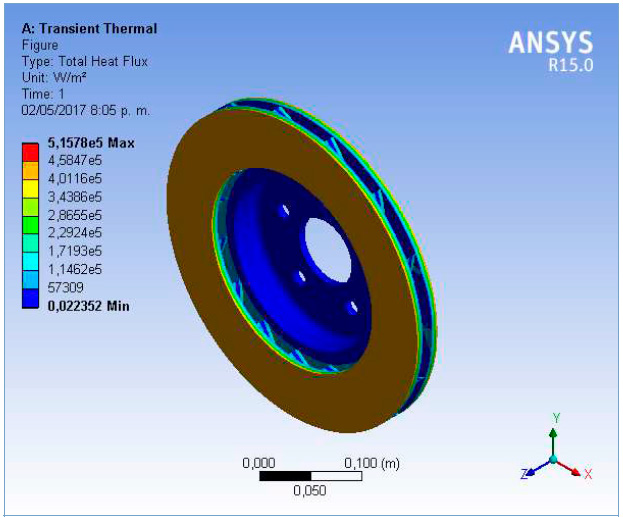Análisis termodinámico de un disco de freno automotriz con pilares de ventilación tipo NACA 66-209
DOI:
https://doi.org/10.17981/ingecuc.14.2.2018.01Palabras clave:
Fricción, FEA, CFD, Frenos de Disco, Automóvil, NACA 66-209., TermodinámicaResumen
Introducción: El sistema de frenado de un automóvil debe trabajar en forma segura y predecible en cualquier circunstancia, lo cual implica disponer de un nivel estable de fricción, en cualquier condición de temperatura, humedad y salinidad del medio ambiente. Para un correcto diseño y operación de los discos de freno, es necesario considerar diferentes aspectos, tales como la geometría, el tipo de material, la resistencia mecánica, la temperatura máxima, la deformación térmica, la resistencia al agrietamiento, entre otros.
Objetivo: En el presente trabajo se realizó el análisis del sistema de freno a partir del pedal como inicio de los cálculos de cinética y dinámica de los elementos constitutivos y de esta manera simular el comportamiento de un freno automotriz con pilares de ventilación tipo NACA 66-209.
Metodología: El desarrollo de la investigación se llevó a cabo mediante la ejecución de un Análisis de Elementos Finitos (FEA) con la ayuda del Software SolidWorks Simulation, donde se llevó a cabo el modelo geométrico del disco con la finalidad de identificar los elementos sometidos a máximas variaciones de temperatura.
Resultados: Los resultados obtenidos demuestran que con los cálculos matemáticos se logró validar el correcto funcionamiento de sistema de frenado a diferentes condiciones de operación, con lo que se pudo optimizar este tipo de geometría para los discos ayudando a la evacuación más rápida de calor respecto a otros tipos de frenos de disco.
Conclusiones: Los resultados demuestran que estos sistemas trabajan en condiciones óptimas siempre garantizando altos niveles de seguridad y operación en comparación con otros tipos de geometrías, además de poder determinar sus condiciones de funcionamiento en diferentes condiciones de trabajo.
Descargas
Citas
R. A. García-León, M. A. Acosta, and E. Flórez, "Análisis del comportamiento de los frenos de disco de los vehículos a partir de la aceleración del proceso de corrosión," Tecnura, vol. 19, no. 45, pp. 53–63, 2015. https://doi.org/10.14483/udistrital.jour.tecnura.2015.3.a04
S. Hirasawa, T. Kawanami, and K. Shirai, "Numerical analysis of convection heat transfer on high-temperature rotating disk at bottom surface of air flow duct," in ASME International Mechanical Engineering Congress and Exposition, Proceedings (IMECE), 2014, vol. 8A. https://doi.org/10.1115/IMECE2014-36142
A. Ocampo Ramírez, "Dise-o de un molino para reciclar pastas de freno de tractocamiones usando el método del elemento finito," Instituto Politécnico Nacional, 2013.
L. S. Bocîi, "The influence of braking time on heat flow through the friction surfaces of the friction elements of disk brakes for railway vehicles," Transport, vol. 26, no. 1, pp. 75–78, 2011. https://doi.org/10.3846/16484142.2011.563494
H. B. Yan, S. S. Feng, X. H. Yang, and T. J. Lu, "Role of cross-drilled holes in enhanced cooling of ventilated brake discs," Appl. Therm. Eng., vol. 91, pp. 318–333, 2015. https://doi.org/10.1016/j.applthermaleng.2015.08.042
Z. Chi, Y. He, and G. Naterer, "Convective heat transfer optimization of automotive brake discs," SAE Int. J. Passeng. Cars - Mech. Syst., vol. 2, no. 1, pp. 961–969, 2009.
F. Klimenda, J. Soukup, and J. Kampo, "Heat distribution in disc brake," in AIP Conference Proceedings, 2016, vol. 1745. https://doi.org/10.1063/1.4953715
W. Wu, Z. Xiong, J. Hu, and S. Yuan, "Application of CFD to model oil-air flow in a grooved two-disc system," Int. J. Heat Mass Transf., vol. 91, pp. 293–301, 2015. https://doi.org/10.1016/j.ijheatmasstransfer.2015.07.092
T. K. R. Rajagopal, R. Ramachandran, M. James, and S. C. Gatlewar, "Numerical investigation of fluid flow and heat transfer characteristics on the aerodynamics of ventilated disc brake rotor using CFD," Therm. Sci., vol. 18, no. 2, pp. 667–675, 2014. https://doi.org/10.2298/TSCI111219204R
Brembo, "The benefits of the new design for the brake disc ventilation chamber.," 2015.
M. N. Dhaubhadel, "CFD applications in the automotive industry (invited keynote presentation)," Am. Soc. Mech. Eng. Fluids Eng. Div. FED, vol. 239, pp. 473–480, 1996.
J. Wurm, M. Fitl, M. Gumpesberger, E. Väisänen, and C. Hochenauer, "Novel CFD approach for the thermal analysis of a continuous variable transmission (CVT)," Appl. Therm. Eng., vol. 103, pp. 159–168, 2016. https://doi.org/10.1016/j.applthermaleng.2016.04.092
M. Pevec, I. Potrc, G. Bombek, and D. Vranesevic, "Prediction of the cooling factors of a vehicle brake disc and its influence on the results of a thermal numerical simulation," Int. J. Automot. Technol., vol. 13, no. 5, pp. 725–733, 2012. https://doi.org/10.1007/s12239-012-0071-y
D. Wei, J. Ruan, W. Zhu, and Z. Kang, "Properties of stability, bifurcation, and chaos of the tangential motion disk brake," J. Sound Vib., vol. 375, pp. 353–365, 2016. https://doi.org/10.1016/j.jsv.2016.04.022
J. Ruan, P. D. Walker, P. A. Watterson, and N. Zhang, "The dynamic performance and economic benefit of a blended braking system in a multi-speed battery electric vehicle," Appl. Energy, vol. 183, pp. 1240–1258, 2016. https://doi.org/10.1016/j.apenergy.2016.09.057
M. Gulec, E. Yolacan, and M. Aydin, "Design, analysis and real time dynamic torque control of single-rotor-single-stator axial flux eddy current brake," IET Electr. Power Appl., vol. 10, no. 9, pp. 869–876, 2016. https://doi.org/10.1049/iet-epa.2016.0022
W. Wei, Y. Hu, Q. Wu, X. Zhao, J. Zhang, and Y. Zhang, "An air brake model for longitudinal train dynamics studies," Vehicle System Dynamics. Taylor and Francis Ltd., School of Traffic and Transportation Engineering, Dalian jiaotong University, Dalian, People's Republic of China, pp. 1–17, 2016.
A. Shahril, R. Samin, J. M. Juraidi, and J. Daut, "Structural analysis of brake disc using dynamic simulation," ARPN J. Eng. Appl. Sci., vol. 10, no. 17, pp. 7805–7808, 2015.
U. Andreaus and P. Casini, "Dynamics of friction oscillators excited by a moving base and/or driving force," J. Sound Vib., vol. 245, no. 4, pp. 685–699, 2001. https://doi.org/10.1006/jsvi.2000.3555
S. W. Shaw, "On the dynamic response of a system with dry friction," J. Sound Vib., vol. 108, no. 2, pp. 305–325, Jul. 1986. https://doi.org/10.1016/S0022-460X(86)80058-X
D. Meng, L. Zhang, and Z. Yu, "A dynamic model for brake pedal feel analysis in passenger cars," Proc. Inst. Mech. Eng. Part D J. Automob. Eng., vol. 230, no. 7, pp. 955–968, 2016. https://doi.org/10.1177/0954407015598030
S.-D. Lee and S.-L. Kim, "Characterization and development of the ideal pedal force, pedal travel, and response time in the brake system for the translation of the voice of the customer to engineering specifications," Proc. Inst. Mech. Eng. Part D J. Automob. Eng., vol. 224, no. 11, pp. 1433–1450, 2010. https://doi.org/10.1243/09544070JAUTO1585
V. Surblys and E. Sokolovskij, "Research of the Vehicle Brake Testing Efficiency," in 9th International Scientific Conference, Transbaltica 2015, 2016, vol. 134, pp. 452–458. https://doi.org/10.1016/j.proeng.2016.01.067
A. Q. Xu, "Study on the dynamic characteristics of a high frequency brake based on giant magnetostrictive material," Smart Mater. Struct., vol. 25, no. 6, 2016. https://doi.org/10.1088/0964-1726/25/6/065001
E. Palmer, R. Mishra, and J. Fieldhouse, "An optimization study of a multiple-row pin-vented brake disc to promote brake cooling using computational fluid dynamics," Proc. Inst. Mech. Eng. Part D J. Automob. Eng., vol. 223, no. 7, pp. 865–875, 2009. https://doi.org/10.1243/09544070JAUTO1053
A. Nagarajan and M. R. Narayanan, "Maximization of efficiency for Disk brake material using composite material by modelling and analysis," Int. J. Control Theory Appl., vol. 9, no. 6, pp. 2793–2798, 2016.
R. A. García-León and E. Perez Rojas, "Analysis of the amount of heat flow between cooling channels in three vented brake discs," Ing. y Univ., vol. 21, no. 1, pp. 55–70, 2017.
L. Pan, J. Han, Z. Li, Z. Yang, and W. Li, "Numerical simulation for train brake disc ventilation," Beijing Jiaotong Daxue Xuebao/Journal Beijing Jiaotong Univ., vol. 39, no. 1, pp. 118–124, 2015.
Y. Cengel, Tansferencia de calor y masa. Un enfoque práctico. Tercera edición. México: McGraw-Hil, 2007.
D. R. Flores Galindo, "Dise-o de perfiles aerodinámicos.," Instituto Politécnico Nacional, 2006.
Airfoill Tools, "NACA 66-209 (naca66209-il)," 2017.
UIUC, "Applied Aerodynamics Group," University of Illinois, 2017. [Online]. Available: http://m-selig.ae.illinois.edu/ads/coord_database.html#N.
R. A. García-León, "Evaluación del comportamiento de los frenos de disco de los vehículos a partir del análisis de la aceleración del proceso de corrosión.," Universidad Francisco de Paula Santander Oca-a, 2014.
R. Limpert, Brake Design and Safety, 2a ed. Society of Automotive Engineers, 1999.
A. Cruz Azanza, C. A. Jiménez García, and M. Á. Ordaz Flores, "Dise-o geométrico de un prototipo optimizado de un disco de freno automotriz ventilado.," 2012.
M. U. Ramirez, "Instituto politécnico nacional," 2012.
Y. a. Cengel and M. E. Boles, "Termodinamica - Cengel 7th," Termodinamica, p. 1456, 2011.
R. A. García-León, "Thermal study in three vented brake discs, using the finite element analysis," DYNA, vol. 84, no. 200, pp. 19–27, 2017. https://doi.org/10.15446/dyna.v84n200.55663
R. A. García-León and E. Flórez-Solano, "Dynamic analysis of three autoventilated disc brakes," Ing. e Investig., vol. 37, no. 3, pp. 102–114, 2017. https://doi.org/10.15446/ing.investig.v37n3.63381
R. A.García-León and E. Flórez, "Estudio analítico de la transferencia de calor por convección que afectan los frenos de disco ventilados," Tecnura, vol. 20, pp. 15–30, 2016.
R. A. García León and E. Pérez Rojas, "Analysis of the amount of heat flow between cooling channels in three vented brake discs," Ing. y Univ., vol. 21, no. 1, pp. 71–96, 2017.
D. Porta, C. Echeverría, A. Aguayo, J. E. H. Cardoso, and C. Stern, Recent Advances in Fluid Dynamics with Environmental Applications. 2016.

Descargas
Publicado
Cómo citar
Número
Sección
Licencia
Los artículos publicados son de exclusiva responsabilidad de sus autores y no reflejan necesariamente las opiniones del comité editorial.
La Revista INGE CUC respeta los derechos morales de sus autores, los cuales ceden al comité editorial los derechos patrimoniales del material publicado. A su vez, los autores informan que el presente trabajo es inédito y no ha sido publicado anteriormente.
Todos los artículos están bajo una Licencia Creative Commons Atribución-NoComercial-SinDerivadas 4.0 Internacional.


 English
English
 Español (España)
Español (España)























